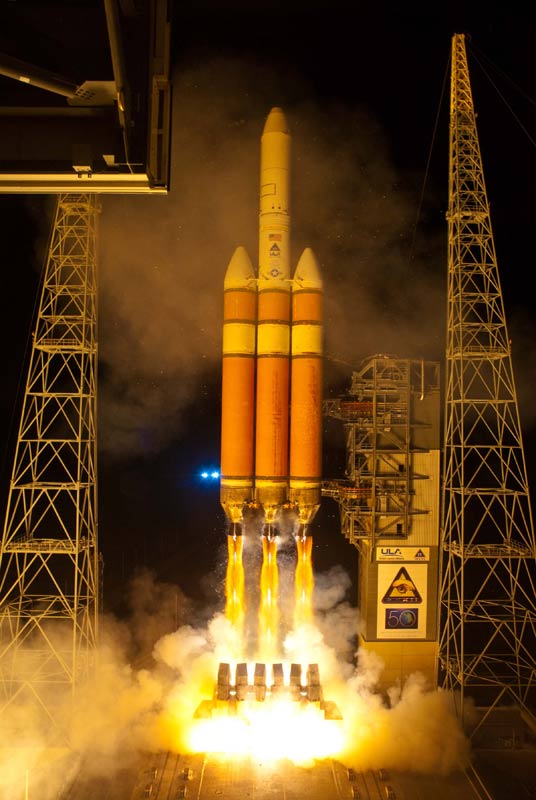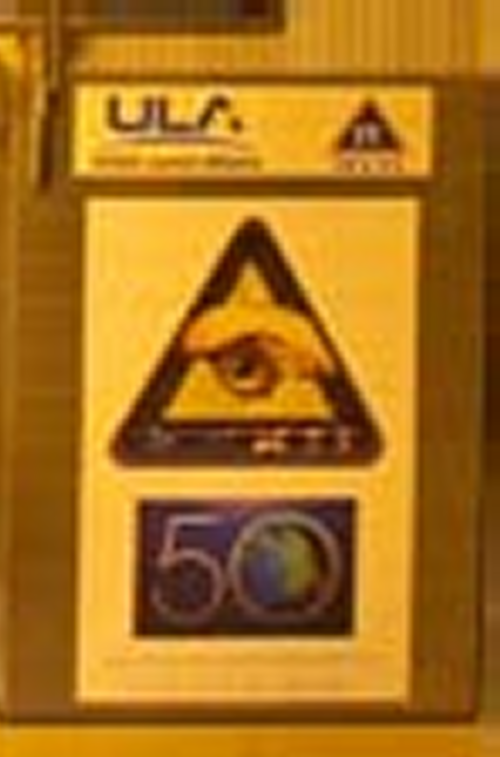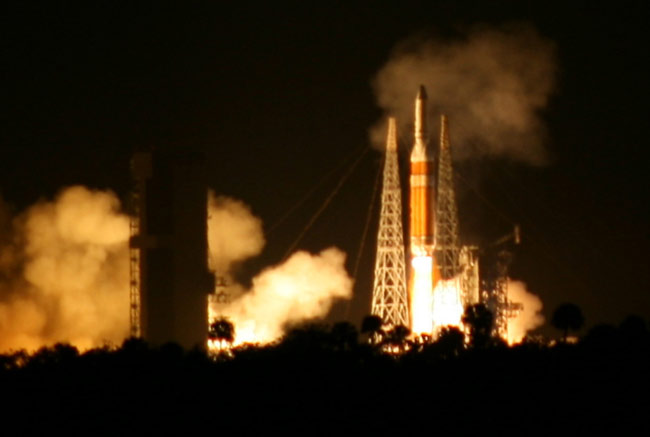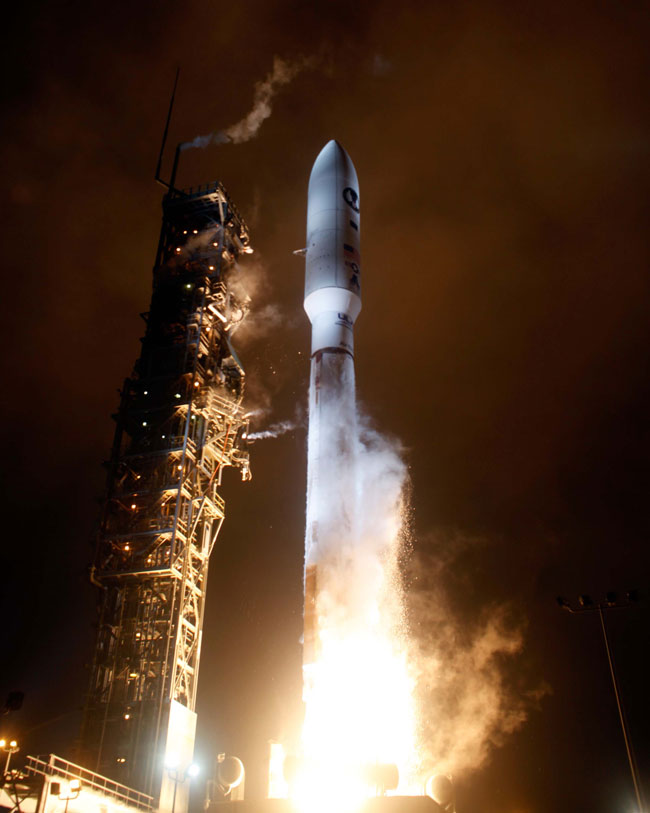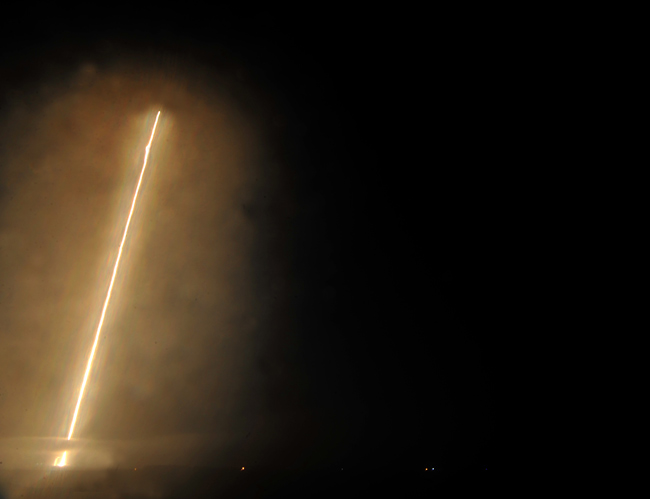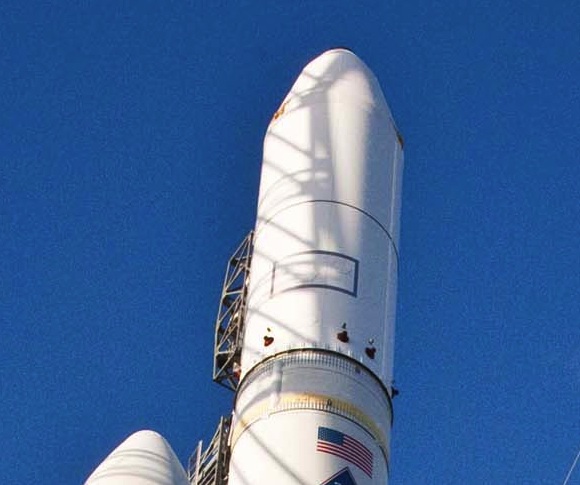|
Secret Satellites |
|||
|
NROL-32 ..
A United Launch Alliance Delta
4 Heavy launches with a National Reconnaissance Office payload NROL-32
from Space Launch Complex-37 at 5:58 p.m. EST (2258 GMT). Credit: Pat Corkery/United
Launch Alliance
Secret U.S. Spy Satellite Launches
Into Orbit on Huge Rocket
A huge unmanned rocket carrying a secret new spy satellite for the United States roared into space Sunday (Nov. 21) to deliver what one reconnaissance official has touted as "the largest satellite in the world" into orbit. The giant booster – a Delta 4 Heavy rocket – blasted off at 5:58 p.m. EST (2258 GMT) from the Cape Canaveral Air Force Base in Florida carrying a classified payload for the U.S. National Reconnaissance Office. "This mission helps to ensure that vital NRO resources will continue to bolster our national defense," said Air Force Brig. Gen. Ed Wilson, commander 45th Space Wing, after the successful launch. The satellite, called NROL-32, launched after a series of delays from technical glitches. The most recent glitch, a pair of faulty temperature sensors, thwarted a Nov. 19 launch attempt. The exact purpose of the new spy satellite NROL-32 is secret, but one NRO official has hinted at the huge size of the reconnaissance spacecraft. In a Sept. 13 address at the Air Force Association's Air and Space Conference, NRO director Bruce Carlson, a retired Air Force general, told an audience that this Delta 4 Heavy rocket would launch "with the largest satellite in the world on it." For comparison, in July 2009 a satellite called TerreStar-1 – touted as the world's largest commercial satellite ever built – launched into space atop an Ariane 5 rocket. TerreStar-1 is 15,233 pounds (6,910 kg) satellite equipped with a huge 60-foot (18-meter) antenna. Last week, the SkyTerra-1 mobile communications satellite launched with its own giant antenna, one that is about 72 feet (nearly 22 meters) across. The Delta 4 Heavy rocket is the United States' biggest unmanned rocket currently in service and has 2 millions pounds of thrust, making it the most powerful liquid fueled booster available today. A Delta 4 Heavy rocket stands 235 feet (72 meters) tall and is actually made up of three boosters, each called a Common Booster Core, arranged in a line to give it a three-column appearance. The rocket is built and launched by the United Launch Alliance, a partnership between Lockheed Martin and Boeing. It made its first flight in 2004 and is capable of launching payloads of up to 24 tons into low-Earth orbit and 11 tons toward the geosynchronous orbits used by communications satellites. Tonight's launch marked the fourth launch of a Delta 4 Heavy rocket and the second satellite launch in three months for the NRO. An Atlas 5 rocket launched the NROL-41 reconnaissance satellite on Sept. 20. In his address last month, Carlson said that the current plan for NRO satellite missions "is the most aggressive launch campaign that the National Reconnaissance Office has had in 20 years, almost a quarter of a century." Carlson went on to say that new satellites are vital for the NRO's mission, and are needed to replace older satellites before they fail. "The other thing I can tell you is these are very important, because they all go to update a constellation which is aging rapidly," Carlson said last month according to an NRO transcript. "We bought most of our satellites for three, five, or eight years, and we're keeping them on orbit for ten, twelve, and up to twenty years." "Now when I buy something people complain about how expensive it is, but nobody ever complains when it's time to die and it keeps right on ticking," Carlson added. "Some of these guys are like the Energizer bunny and they have really done marvelous work." SOURCE: Space.com Related Links:
|
|||
|
..
..
|
|||
|
|||
|
..
Final 'Misty' stealth spysat placed in covert orbit? By Lewis Page 21st January 2011 The US intelligence services have launched a large secret payload into space using one of the most powerful rockets currently available, a mighty Delta IV Heavy, which took off for the first time from the west coast last night. The launch, from the Vandenberg military space base in California, took place at 9:10 pm UK time. It was the inaugural takeoff of a Delta IV Heavy from Vandenberg's Space Launch Complex Six (SLC-6), once intended to send military Space Shuttle missions into orbit. Until yesterday, the massive Delta had only flown from Cape Canaveral airforce station in Florida. Fully $100m had been spent upgrading the SLC-6 launch facility to take the Delta. Launches from the west coast are desirable from a security point of view as the planet rotates beneath the departing spacecraft, ensuring that it is over the ocean rather than land as it rises into orbit. This makes it harder for interested parties to track the ascent and immediately work out details of the orbit the payload may wind up on. The Delta IV Heavy makes use of three RS-68 engines in the first stage and an RL-10 in the upper stage. All of them burn cryogenic liquefied hydrogen in oldschool style, rather than trendier (and much cheaper and easier to handle) kerosene or solid fuel. Though much effort was expended during the design of the big rocket on attempting to cut launch costs, it proved unable to compete in the commercial launch market, and four of the five launches to date (including yesterday's) have carried military/spy satellites. The other was the initial test launch, which was only partially successful. There has been discussion around using the Delta IV Heavy to carry astronauts into space, but thus far without result. For now its sole task would seem likely to be the one executed yesterday: carrying secret payloads into space for the US intelligence community. The massive 23-stories-high rocket stack is capable of delivering over 22 tonnes to low orbit, though yesterday's delivery is likely to have gone into a high-angle polar track - in order to bring more of the Earth beneath its surveillance footprint - and thus probably will have massed somewhat less. (Polar orbits forfeit the helpful speed boost offered by the planet's rotation, and demand more of the launch rocket than equatorial ones.) Few details regarding the cargo carried on yesterday's launch were released, though it is known that the payload belongs to the US National Reconnaissance Office (NRO), in charge of spy satellites. We are also informed that it fitted into a payload fairing 63 feet long and just under 17 feet in diameter. Based on previous form, the secret satellite or satellites' orbit will presently be discovered by amateur skywatchers - and probably sooner by foreign powers with space capabilities. It (or they) will occasionally shift orbit and elude the watchers below for a time. The NRO formerly tried to design "stealth" satellites which would not be so easily detected - the so-called "Misty" series, two of which are thought to have been launched in 1990 and 1999. The "city bus sized" stealthy sats were rumoured to be wildly expensive, and the first one at least was spotted and tracked anyway. The Misty programme was reportedly cancelled altogether in 2007 due to cost overruns and doubts over its usefulness - though this has naturally not been confirmed. Some analysts and skywatchers believed that the third Misty would be so massive that only the Delta IV Heavy could lift it - and even the mighty Delta might need expensive upgrading for such a task. Such upgrades would be paid for out of the "black" or secret budget, so it's still just possible that yesterday's Delta was such an enhanced version carrying the "Misty 3" which has long been speculated upon among secret-sat spotters, and which was originally supposed to be ready for launch by last year. The expensive enhancements at Vandenberg's SLC-6, devoted to achieving a more clandestine orbital insertion, would fit well with such a theory - though also, of course, with a more humdrum spy-sat deployment. ® Source: The Register |
|||
| FAIR USE NOTICE: This page contains copyrighted material the use of which has not been specifically authorized by the copyright owner. Pegasus Research Consortium distributes this material without profit to those who have expressed a prior interest in receiving the included information for research and educational purposes. We believe this constitutes a fair use of any such copyrighted material as provided for in 17 U.S.C § 107. If you wish to use copyrighted material from this site for purposes of your own that go beyond fair use, you must obtain permission from the copyright owner. | |||
|
|
